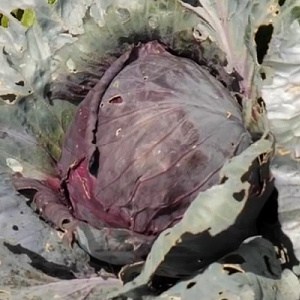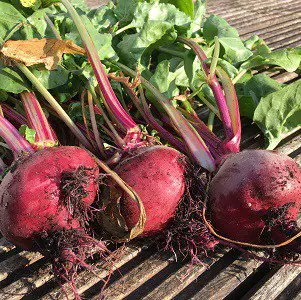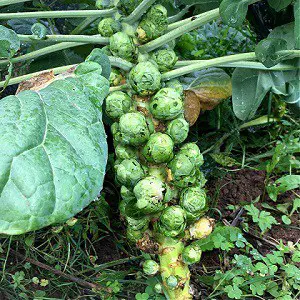Veg Seeds to Sow in February and Early Spring
What to sow in February
What seeds can I sow in February? Well there are actually quite a lot of them. You will need to adjust your sowing times according to where you live and what your local conditions. I’ve checked our local conditions. I searched for ‘frost dates’, the site I found confirmed that our last frost is at the end of April. From then on is a good time for us to harden off seedlings, ready to plant out in the garden.
This article goes hand in hand with a video of seeds to sow in February on my YouTube channel, Liz Zorab – Byther Farm. If you are short of time, skip to the bottom of page for a recap of veg seeds and links to suppliers in UK, while USA links are found within the article.
Disclosure. Some of these are affiliate links. In other words, if you make a purchase we may earn a small commission. View our full disclosure statement.
Starting Seeds With Heat
Summer cabbages
In 2019 I grew a really nice variety called Filderkraut, I really liked its taste. It’s a pointed cabbage and I gave the outer leaves to the ducks, but you could eat those. The cabbage was equally good hot and cold. It was cooked and served as a side dish, but also sliced very finely and used in a coleslaw salad. In USA, try Early Jersey Wakfield. I’m also going to try another variety called Dostenfelder Dauer.
Red cabbages

I love red cabbage, I like it as coleslaw and I like it braised very slowly with some wine and some spices and some apples. It is frozen for use throughout the winter. I will make at least two sowings of the Red Acre – towards the end of February and then probably the end of April, so that I get two crops. In USA, a similar cabbage is Mammoth Red Rock Cabbage.
Cauliflowers
I’m still sowing All The Year Round. The first sowing in October failed miserably, however the ones in November have done fine. I will sow again now in February, because I don’t want a whole host of cauliflowers all at one time. Just a really small amount to grow three or four plants, because what am I going to do with a glut of cauliflower? I would rather have a small number to harvest over a longer period and then we will actually use them. I’m not a fan of frozen cauliflower. A staggered sowing resulting in a staggered crop is a much better idea. In USA, try a Self Blanching Cauliflower from MI Gardener.
Celeriac
Giant Prague Improved. I don’t start this now as I don’t have a heat source for seeds. I will wait a little bit, but if you have the warmth you can do that.
Celery
Last year I grew like a salad celery, one that you can just to eat the stalk. This year I’m going back to one that I’ve grown before which is called Celery Red Soup and the stalks have a purple-red tinge to them. I find the taste incredibly strong. Much too strong just to eat a stick raw, but in soups and vegetable stock it was absolutely wonderful. In USA, Pink Plume celery is similar.
Leeks
I’m growing an awful lot of leeks this year and again I will be growing a lot different varieties, like Musselburgh, I will be staggering their sowing periods so that I can harvest them over a really long period during the winter. In 2019 I grew loads of leeks and then I gave loads them away and I didn’t actually plant enough for us! I like the mild oniony taste of leeks in a lot of food. I like them as a side dish and I also like leeks in stews and soups. During winter I thrive on soup and on stew, so for me it’s worth growing the extra leeks. In USA, try Large American Flag leeks, which I have grown very successfully in our garden in the equivalent of zone 8.
Onion Seeds
I think I’ve said before I’ve never grown onions from seed before. I’ve always used sets into the ground. But for 2020 I will be trying Senshyu Yellow and Bedfordshire Champion from seed. In USA, try Utah Yellow Sweet Spanish onions.
Shallot Onion
Zubrune shallots have pink skin and an elongated shape. I really like the mild, almost sweet, taste of them, particularly if I cook them really slowly in a pan and let them almost caramelise, they’re just fabulous!
Tomatoes
If you have the heat start tomatoes. Three years ago I decided I wasn’t going to grow any tomatoes and you persuaded me that I should have some and I did. Last year I was given a load of tomato plants I absolutely loved them. This year I will sow Moneymaker, also San Marzano a plum tomato (in USA, try Roma tomato), cherry tomato Cerise (in USA, try Tess’s Land Race Currant tomato) and yellow tomato Sunrise (in USA, try Sunray tomato).
I will wait for another four weeks before I start tomatoes. If you intend to grow them outside, don’t plant your seeds more than about eight weeks before your last frost date. Otherwise the plants will get too leggy and too hungry. They will end up getting stunted before you can actually get them into the ground.
So that’s what you can start now if you’ve got some heat. If like me you have some covered area but no heat, don’t worry there’s still plenty of things that you can so now. Again, adjust your sowing times for your area, so further north and in colder areas you’re going to push these times back and right to the end of the month or even to the beginning of March.
I can only talk about averages and you really must check your frost dates. Try not to sow hundreds of seeds for your windowsill or your greenhouse or your polytunnel that you’re not going to be able to get outside, they’re just going to become incredibly leggy and you’ll need to sow again. Here are my suggestions and my favourite varieties of seeds to sow in February.
What to sow in February under cover without heat
Beetroot. Beets.

Boltardy is my favourite, it’s a really nice round-ish beetroot. I just like the flavour of it and I like the consistency of it. I have already planted some of these but for their baby beet leaves rather than for the roots. And at the end of February I’ll start sowing this into modules, two or three seeds per module, and then I can just plant them out in small clusters and they’ll grow on from there. Detroit Dark Red (USA link) is a similar beet, that I also like the flavor.
I’m also growing a white beetroot, Albino. I like the flavour of it, it’s slightly milder and I found it slightly sweeter. I’m hoping this year to grow enough of that that I will be able to make a white beetroot wine towards the end of the year.
Broadbeans. Fava beans
Aquadulce Claudia The reason that I don’t sow broad beans in autumn and I wait until February is that, in previous years I’ve sown them, they’ve grown absolutely beautifully and even though our ducks do an excellent detective job on the slugs and snails in the veg garden, when I’ve planted my broad beans out, they’ve just been snaffled by the snails. All I’m left with is sad, little stumps. If I sow them now, it’s a little bit further into the season I can get them really big strong plants before I put them out and then hopefully they will survive the slug and snail onslaught. In USA, try this Fava bean.
Brussels Sprouts

I’ve really enjoyed our Brussels sprouts, Evesham Special this year. I started picking those a couple of weeks before Christmas. Here we are, beginning February, I’m still harvesting them and I only grew six plants, but I’m not harvesting a huge number at any one time. I did have some for breakfast yesterday morning, yes I know, for breakfast! But it was just what I fancied and they were just lovely with some eggs. Sow those now, according to your area, and in a few weeks time you can start hardening them off and get them outside. They do need a really long growing period.
In USA, try Long Island Brussel sprouts, but check your growing conditions as they may need less growing time if you have a warmer climate. They are unlikely to grow well if you have very hot summers.
Carrots
Amsterdam 2 solo, Amsterdam 3 Sprint These will be growing in the polytunnel all the way through, so I will just sow them in rows and keep my fingers crossed because I’m a bit hit-and-miss with carrots. Some years I do really well, other years I don’t. Last year was a good year, so I’m hoping and 2020 will be too.
In USA, Scarlet Nantes carrots are popular with many gardeners.
Cauliflower
Not only will I have All The Year Round on the go, but also a green one. You may have seen this in the shops, the heads rather than being round, kind of have points on them, they look almost like a lunar landscape and I love them. They’re called Romanesco and I will be sowing a few of those. Di Sicilia Violetto (in USA, Purple of Sicily) and these are a purple and pale mauve-purple cauliflower head. The ones I grew last year didn’t grow very big, they were really small but oh good grief, they were tasty!
Salad Leaves
And you can also sow salad leaves like Mizuna, I’ve got a mustard here called Green in the Snow, I also grow the mustard Oriental Ruby Streaks (Mizuna Red Streaks), which is a deep red color, quite mustardy as the leaves get bigger, but very small leaves almost have a caramel taste to them to start with and then the more you chew them, the more that mustardy heat comes through.
And also on the recommendation of a fellow content creator and gardener I’m going to try Lettuce Salanova and this one is called Expertise RZ. Apparently leaves are exceptionally tolerant to cold and exceptionally tolerant to heat and I’ve got to say they were exceptionally pricey seeds. So I’m going to be really interested to see how these do. They’re like a cut and come again but rather than individual leaves you can actually just cut the head and it will regrow. So I’m really looking forward to trying that and I will report back on the results of it later in the year.
Spring Onions
I’m going to do some spring onions. I have already got a row of spring onions in, I can see that one has started to come up. The two varieties that I’m growing are Performer and White Lisbon. I have also found success with Guardsman Bunching onions.
Radishes
And to go with those spring onions I’m also going to plant some radishes. Now so I’ve got three varieties one is French Breakfast, it’s that ‘pink at the top and white at the bottom’ standard recognizable radish, one is called Cherry Belle and is more of a globe, smaller circular radish and I’m also going to try it a little little white radish this is called Albena. I’m really looking forward to trying it and to see if having a white color gives it a milder flavor or not. In USA, try a white variety called Hailstone.
Peas and Snowpeas

Both peas and snow pea seeds are included in my guide of what to sow in February. I’m putting them into guttering suspended in our polytunnel. I drilled some holes in the bottom of the guttering, filled it with compost, sown my pea seeds on top and they’ve been growing away really nicely since the autumn. I’m now going to do some more and rather than staying in the polytunnel for the season, these Oregon Sugarpod (Oregon Giant pea) will get taken outside. I’ll dig a shallow trench in the soil, take the guttering and very gently move it like that and hopefully the peas in their compost will slide out, down into the channel that I’ve made, giving very little root disturbance for the peas.
Spinach
Sowing under cover you can get some spinach in now. I’ve got a Perpetual spinach, but for me it actually doesn’t matter what sort of spinach it is, I’m growing it for the baby leaves to add salads. I eat a lot of salads and I’m not hugely keen on spinach as a large leaf, but I do like it as a baby leaf. I either sow it in a row quite thickly or several in a module and then plant the modules out. In USA, try New Zealand spinach.
Turnips

I’ll be starting these in modules so they can go outside with minimum root disturbance. Last year I was given several different types of turnips to try. The one that I liked the most is a white skinned one, but I’m also going to be trying Purple Top Milan (in USA, try Purple White Globe) and one called Petrowski. These seeds are saved in an envelope, but I have remembered to label them. So there we go, a race through some of the things that can be sown during February.
One more time I’m going to remind you to adjust your sowing times according to your area. It would be awful just to sow a whole load of seeds only to have to repurchase and re-sow them in a month or twos time. Below is a quick list of seeds featured in this What to sow in February guide, together with links to purchase the seeds in UK.
UK seed resources for Starting Seeds With Heat
Summer cabbages – Filderkraut, Dostenfelder Dauer
Red Cabbages – Red Acre
Cauliflowers – All The Year Round
Celeriac – Giant Prague
Celery – Celery Red Soup
Leeks – Musselburgh
Onion Seeds – Senshyu Yellow, Bedfordshire Champion
Shallot Onion – Zebrune
Tomatoes – Moneymaker, San Marzano
Cherry Tomato – Cerise
Yellow Tomato – Sunrise
What to sow in February Undercover Without Heat
Beetroots – Boltardy
White Beetroot – Albino Beetroot
Broadbeans – Aquadulce Claudia
Brussel Sprouts – Evesham Special
Carrots – Amsterdam 2 solo, Amsterdam 3 Sprint
Cauliflower – Romanesco, Di Sicilia Violetto
Salad Leaves – Mizuna, Green in Snow, Mustard Oriental Ruby Streaks
Lettuce Salanova – Expertise RZ.
Spring Onions – Performer, White Lisbon
Radishes – French Breakfast, Cherry Belle, Albena
Peas – Oregon Sugarpod, Rondo, Meteor
Spinach – Perpetual
Turnips – Purple Top Milan, Petrowski
Further Reading
You may also like What to Sow in March and for ideas of some of the other tasks you can do this month, check out how to enhance the garden with flowers to sow in February and Wildlife garden jobs in February.
- Romantic garden ideas in June - June 30, 2024
- Mulching, grow with less effort and less watering - June 26, 2024
- Slug Control – How to get rid of slugs in garden - June 26, 2024

Thank you for what to sow in February. I adore sprouts but I’m not sure I could eat them for brekkie. I have your book and follow you on you tube. Really appreciate your advice